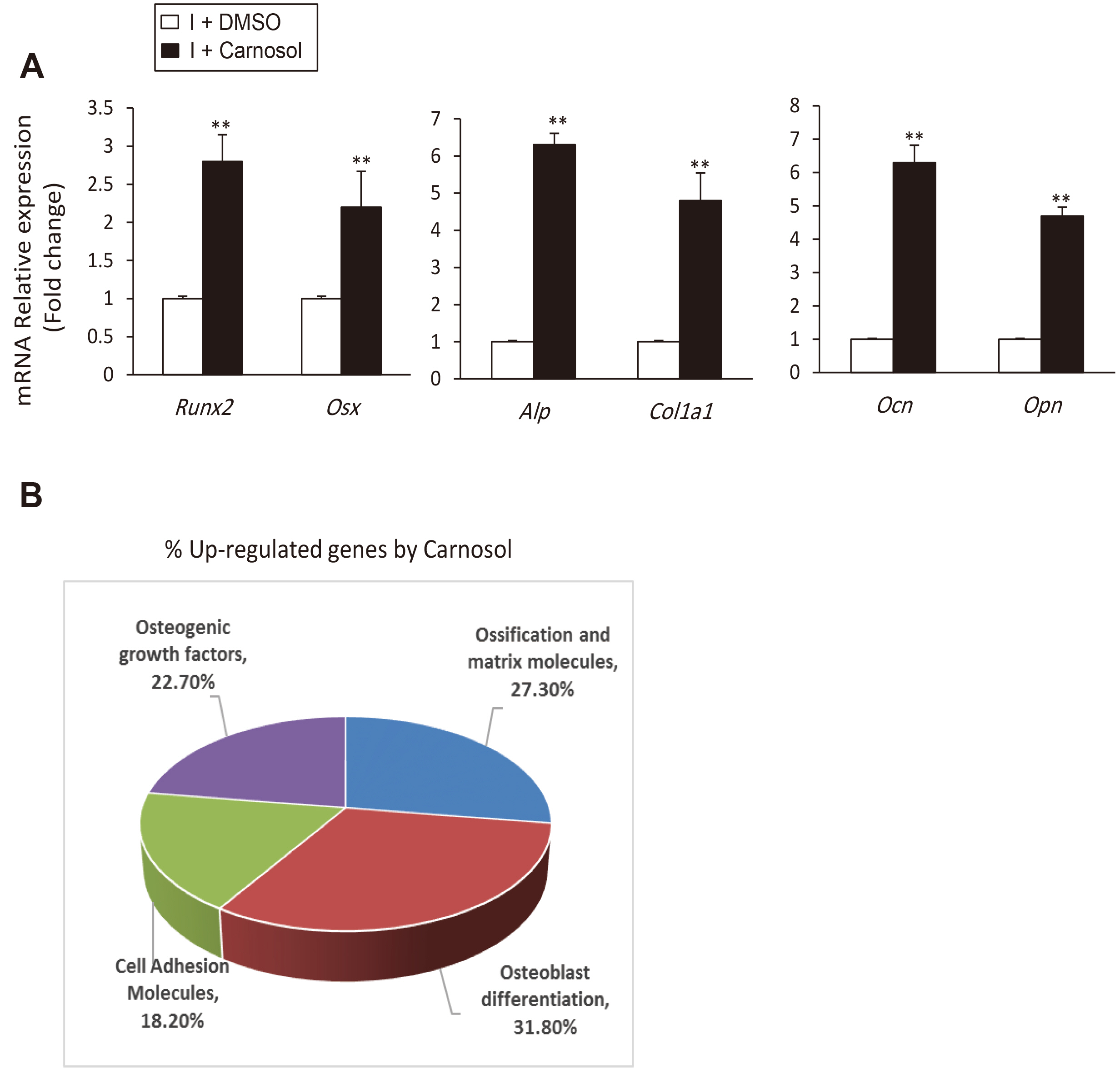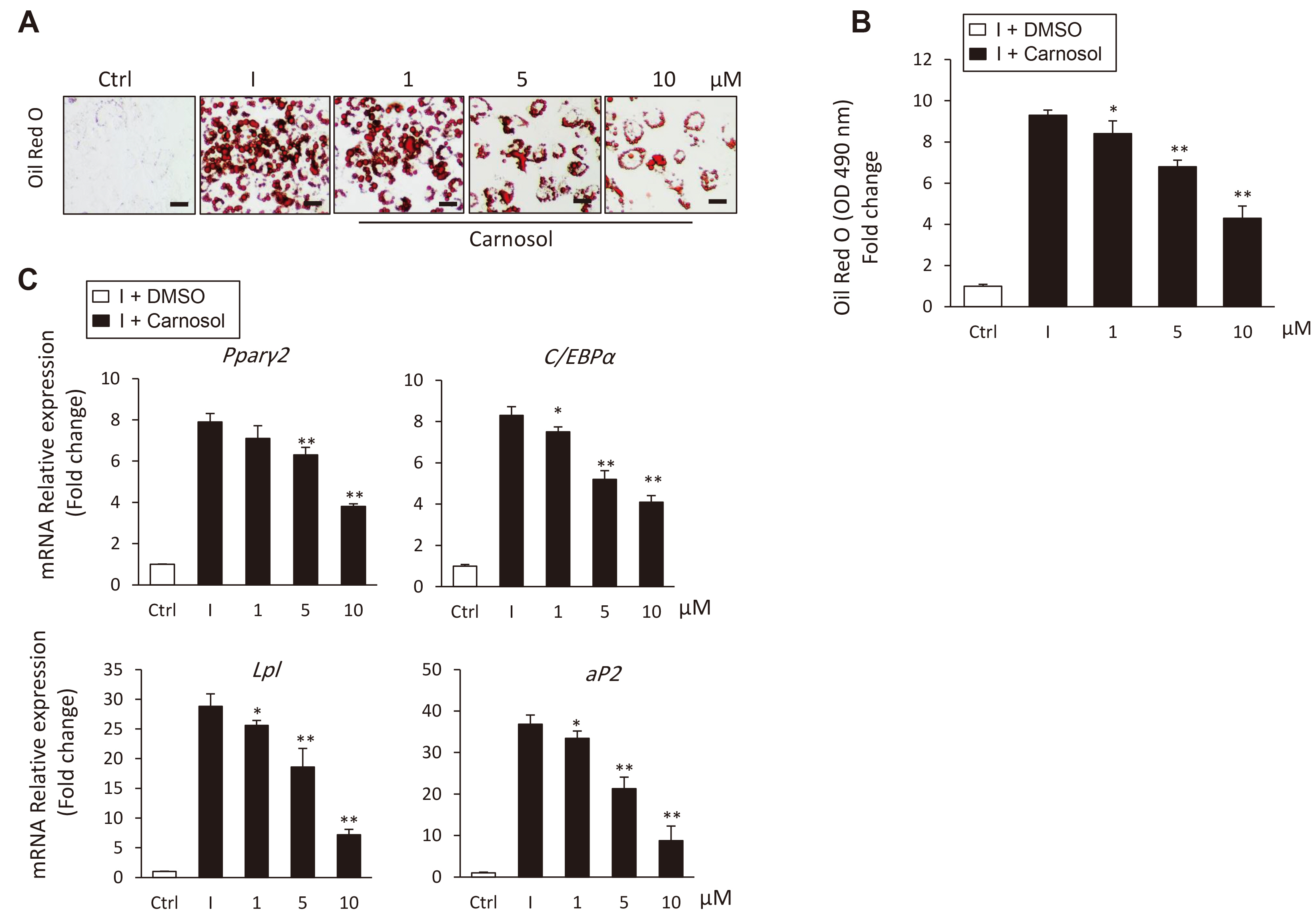Korean J Physiol Pharmacol.
2021 May;25(3):197-206. 10.4196/kjpp.2021.25.3.197.
Carnosol induces the osteogenic differentiation of bone marrowderived mesenchymal stem cells via activating BMP-signaling pathway
- Affiliations
-
- 1Department of Biological Sciences, College of Science, King Faisal University, Al-Ahsa 31982, Saudi Arabia
- KMID: 2514945
- DOI: http://doi.org/10.4196/kjpp.2021.25.3.197
Abstract
- Carnosol is a phenolic diterpene phytochemical found in rosemary and sage with reported anti-microbial, anti-oxidant, anti-inflammatory, and anti-carcinogenic activities. This study aimed to investigate the effect of carnosol on the lineage commitment of mouse bone marrow-derived mesenchymal stem cells (mBMSCs) into osteoblasts and adipocytes. Interestingly, carnosol stimulated the early commitment of mBMSCs into osteoblasts in dose-dependent manner as demonstrated by increased levels of alkaline phosphatase activity and Alizarin red staining for matrix mineralization. On the other hand, carnosol significantly suppressed adipogenesis of mBMSCs and downregulated both early and late markers of adipogenesis. Carnosol showed to induce osteogenesis in a mechanism mediated by activating BMP signaling pathway and subsequently upregulating the expression of BMPs downstream osteogenic target genes. In this context, treatment of mBMSCs with LDN-193189, BMPR1 selective inhibitor showed to abolish the stimulatory effect of carnosol on BMP2-induced osteogenesis. In conclusion, our data identified carnosol as a novel osteoanabolic phytochemical that can promote the differentiation of mBMSCs into osteoblasts versus adipocytes by activating BMP-signaling.
Keyword
Figure
Reference
-
1. Kim JM, Lin C, Stavre Z, Greenblatt MB, Shim JH. 2020; Osteoblast-osteoclast communication and bone homeostasis. Cells. 9:2073. DOI: 10.3390/cells9092073. PMID: 32927921. PMCID: PMC7564526.
Article2. Russow G, Jahn D, Appelt J, Märdian S, Tsitsilonis S, Keller J. 2018; Anabolic therapies in osteoporosis and bone regeneration. Int J Mol Sci. 20:83. DOI: 10.3390/ijms20010083. PMID: 30587780. PMCID: PMC6337474.
Article3. Abdallah BM, Jafari A, Zaher W, Qiu W, Kassem M. 2015; Skeletal (stromal) stem cells: an update on intracellular signaling pathways controlling osteoblast differentiation. Bone. 70:28–36. DOI: 10.1016/j.bone.2014.07.028. PMID: 25138551.
Article4. Abdallah BM, Kassem M. 2008; Human mesenchymal stem cells: from basic biology to clinical applications. Gene Ther. 15:109–116. DOI: 10.1038/sj.gt.3303067. PMID: 17989700.
Article5. Park-Min KH. 2019; Metabolic reprogramming in osteoclasts. Semin Immunopathol. 41:565–572. DOI: 10.1007/s00281-019-00757-0. PMID: 31552471. PMCID: PMC7671717.
Article6. Abdallah BM, Kassem M. 2009; The use of mesenchymal (skeletal) stem cells for treatment of degenerative diseases: current status and future perspectives. J Cell Physiol. 218:9–12. DOI: 10.1002/jcp.21572. PMID: 18726996.
Article7. Bianco P, Robey PG. 2015; Skeletal stem cells. Development. 142:1023–1027. DOI: 10.1242/dev.102210. PMID: 25758217. PMCID: PMC4360182.
Article8. Abdallah BM, Kassem M. 2012; New factors controlling the balance between osteoblastogenesis and adipogenesis. Bone. 50:540–545. DOI: 10.1016/j.bone.2011.06.030. PMID: 21745614.
Article9. Bartold M, Gronthos S, Haynes D, Ivanovski S. 2019; Mesenchymal stem cells and biologic factors leading to bone formation. J Clin Periodontol. 46 Suppl 21:12–32. DOI: 10.1111/jcpe.13053. PMID: 30624807.
Article10. Ditano-Vázquez P, Torres-Peña JD, Galeano-Valle F, Pérez-Caballero AI, Demelo-Rodríguez P, Lopez-Miranda J, Katsiki N, Delgado-Lista J, Alvarez-Sala-Walther LA. 2019; The fluid aspect of the mediterranean diet in the prevention and management of cardiovascular disease and diabetes: the role of polyphenol content in moderate consumption of wine and olive oil. Nutrients. 11:2833. DOI: 10.3390/nu11112833. PMID: 31752333. PMCID: PMC6893438.
Article11. Gotsis E, Anagnostis P, Mariolis A, Vlachou A, Katsiki N, Karagiannis A. 2015; Health benefits of the Mediterranean Diet: an update of research over the last 5 years. Angiology. 66:304–318. DOI: 10.1177/0003319714532169. PMID: 24778424.12. Chang CH, Chyau CC, Hsieh CL, Wu YY, Ker YB, Tsen HY, Peng RY. 2008; Relevance of phenolic diterpene constituents to antioxidant activity of supercritical CO2 extract from the leaves of rosemary. Nat Prod Res. 22:76–90. DOI: 10.1080/14786410701591754. PMID: 17999341.13. Andrade JM, Faustino C, Garcia C, Ladeiras D, Reis CP, Rijo P. 2018; Rosmarinus officinalis L.: an update review of its phytochemistry and biological activity. Future Sci OA. 4:FSO283. DOI: 10.4155/fsoa-2017-0124. PMID: 29682318. PMCID: PMC5905578.14. Weckesser S, Engel K, Simon-Haarhaus B, Wittmer A, Pelz K, Schempp CM. 2007; Screening of plant extracts for antimicrobial activity against bacteria and yeasts with dermatological relevance. Phytomedicine. 14:508–516. DOI: 10.1016/j.phymed.2006.12.013. PMID: 17291738.
Article15. Samarghandian S, Azimi-Nezhad M, Farkhondeh T. 2018; Anti-carcinogenic effects of carnosol- an updated review. Curr Drug Discov Technol. 15:32–40. DOI: 10.2174/1570163814666170413121732. PMID: 28412913.16. González-Vallinas M, Reglero G, Ramírez de Molina A. 2015; Rosemary (Rosmarinus officinalis L.) extract as a potential complementary agent in anticancer therapy. Nutr Cancer. 67:1221–1229. DOI: 10.1080/01635581.2015.1082110. PMID: 26452641.17. Lin C, Zhang X, Su Z, Xiao J, Lv M, Cao Y, Chen Y. 2019; Carnosol improved lifespan and healthspan by promoting antioxidant capacity in Caenorhabditis elegans. Oxid Med Cell Longev. 2019:5958043. DOI: 10.1155/2019/5958043. PMID: 31341531. PMCID: PMC6612998.18. Sanchez C, Horcajada MN, Membrez Scalfo F, Ameye L, Offord E, Henrotin Y. 2015; Carnosol inhibits pro-inflammatory and catabolic mediators of cartilage breakdown in human osteoarthritic chondrocytes and mediates cross-talk between subchondral bone osteoblasts and chondrocytes. PLoS One. 10:e0136118. DOI: 10.1371/journal.pone.0136118. PMID: 26292290. PMCID: PMC4546401.
Article19. Schwager J, Richard N, Fowler A, Seifert N, Raederstorff D. 2016; Carnosol and related substances modulate chemokine and cytokine production in macrophages and chondrocytes. Molecules. 21:465. DOI: 10.3390/molecules21040465. PMID: 27070563. PMCID: PMC6274263.
Article20. Oliviero F, Scanu A, Zamudio-Cuevas Y, Punzi L, Spinella P. 2018; Anti-inflammatory effects of polyphenols in arthritis. J Sci Food Agric. 98:1653–1659. DOI: 10.1002/jsfa.8664. PMID: 28886220.
Article21. Li Y, Lin S, Liu P, Huang J, Qiu J, Wen Z, Yuan J, Qiu H, Liu Y, Liu Q, Zhou T, Luo P, Guo H, Ma Y, Guo D, Mo G, Tang Y, Xu L, Liang D, Xu J, et al. 2021; Carnosol suppresses RANKL-induced osteoclastogenesis and attenuates titanium particles-induced osteolysis. J Cell Physiol. 236:1950–1966. DOI: 10.1002/jcp.29978. PMID: 32722851.
Article22. Abdallah BM, Alzahrani AM, Abdel-Moneim AM, Ditzel N, Kassem M. 2019; A simple and reliable protocol for long-term culture of murine bone marrow stromal (mesenchymal) stem cells that retained their in vitro and in vivo stemness in long-term culture. Biol Proced Online. 21:3. DOI: 10.1186/s12575-019-0091-3. PMID: 30733647. PMCID: PMC6357407.
Article23. Abdallah BM, Alzahrani AM, Kassem M. 2018; Secreted Clusterin protein inhibits osteoblast differentiation of bone marrow mesenchymal stem cells by suppressing ERK1/2 signaling pathway. Bone. 110:221–229. DOI: 10.1016/j.bone.2018.02.018. PMID: 29476977.
Article24. Loussouarn M, Krieger-Liszkay A, Svilar L, Bily A, Birtić S, Havaux M. 2017; Carnosic acid and carnosol, two major antioxidants of rosemary, act through different mechanisms. Plant Physiol. 175:1381–1394. DOI: 10.1104/pp.17.01183. PMID: 28916593. PMCID: PMC5664485.
Article25. Johnson JJ. 2011; Carnosol: a promising anti-cancer and anti-inflammatory agent. Cancer Lett. 305:1–7. DOI: 10.1016/j.canlet.2011.02.005. PMID: 21382660. PMCID: PMC3070765.
Article26. Wu M, Chen G, Li YP. 2016; TGF-β and BMP signaling in osteoblast, skeletal development, and bone formation, homeostasis and disease. Bone Res. 4:16009. DOI: 10.1038/boneres.2016.9. PMID: 27563484. PMCID: PMC4985055.
Article27. Franceschi RT, Xiao G. 2003; Regulation of the osteoblast-specific transcription factor, Runx2: responsiveness to multiple signal transduction pathways. J Cell Biochem. 88:446–454. DOI: 10.1002/jcb.10369. PMID: 12532321.
Article28. Halloran D, Durbano HW, Nohe A. 2020; Bone morphogenetic protein-2 in development and bone homeostasis. J Dev Biol. 8:19. DOI: 10.3390/jdb8030019. PMID: 32933207. PMCID: PMC7557435.
Article29. Martin D, Rojo AI, Salinas M, Diaz R, Gallardo G, Alam J, De Galarreta CM, Cuadrado A. 2004; Regulation of heme oxygenase-1 expression through the phosphatidylinositol 3-kinase/Akt pathway and the Nrf2 transcription factor in response to the antioxidant phytochemical carnosol. J Biol Chem. 279:8919–8929. DOI: 10.1074/jbc.M309660200. PMID: 14688281.
Article30. Allegra A, Tonacci A, Pioggia G, Musolino C, Gangemi S. 2020; Anticancer activity of Rosmarinus officinalis L.: mechanisms of action and therapeutic potentials. Nutrients. 12:1739. DOI: 10.3390/nu12061739. PMID: 32532056. PMCID: PMC7352773.31. Chun KS, Kundu J, Chae IG, Kundu JK. 2014; Carnosol: a phenolic diterpene with cancer chemopreventive potential. J Cancer Prev. 19:103–110. DOI: 10.15430/JCP.2014.19.2.103. PMID: 25337578. PMCID: PMC4204164.
Article32. Vergara D, Simeone P, Bettini S, Tinelli A, Valli L, Storelli C, Leo S, Santino A, Maffia M. 2014; Antitumor activity of the dietary diterpene carnosol against a panel of human cancer cell lines. Food Funct. 5:1261–1269. DOI: 10.1039/c4fo00023d. PMID: 24733049.
Article33. Johnson JJ, Syed DN, Heren CR, Suh Y, Adhami VM, Mukhtar H. 2008; Carnosol, a dietary diterpene, displays growth inhibitory effects in human prostate cancer PC3 cells leading to G2-phase cell cycle arrest and targets the 5'-AMP-activated protein kinase (AMPK) pathway. Pharm Res. 25:2125–2134. DOI: 10.1007/s11095-008-9552-0. PMID: 18286356. PMCID: PMC2994272.34. Johnson JJ, Syed DN, Suh Y, Heren CR, Saleem M, Siddiqui IA, Mukhtar H. 2010; Disruption of androgen and estrogen receptor activity in prostate cancer by a novel dietary diterpene carnosol: implications for chemoprevention. Cancer Prev Res (Phila). 3:1112–1123. DOI: 10.1158/1940-6207.CAPR-10-0168. PMID: 20736335. PMCID: PMC2978906.
Article35. Takahashi T, Tabuchi T, Tamaki Y, Kosaka K, Takikawa Y, Satoh T. 2009; Carnosic acid and carnosol inhibit adipocyte differentiation in mouse 3T3-L1 cells through induction of phase2 enzymes and activation of glutathione metabolism. Biochem Biophys Res Commun. 382:549–554. DOI: 10.1016/j.bbrc.2009.03.059. PMID: 19289108.
Article36. Ninomiya K, Matsuda H, Shimoda H, Nishida N, Kasajima N, Yoshino T, Morikawa T, Yoshikawa M. 2004; Carnosic acid, a new class of lipid absorption inhibitor from sage. Bioorg Med Chem Lett. 14:1943–1946. DOI: 10.1016/j.bmcl.2004.01.091. PMID: 15050633.
Article37. Samarghandian S, Borji A, Farkhondeh T. 2017; Evaluation of antidiabetic activity of carnosol (phenolic diterpene in rosemary) in streptozotocin-induced diabetic rats. Cardiovasc Hematol Disord Drug Targets. 17:11–17. DOI: 10.2174/1871529X16666161229154910. PMID: 28034282.
Article38. Abdallah BM, Ali EM. 2019; 5'-hydroxy Auraptene stimulates osteoblast differentiation of bone marrow-derived mesenchymal stem cells via a BMP-dependent mechanism. J Biomed Sci. 26:51. DOI: 10.1186/s12929-019-0544-7. PMID: 31277646. PMCID: PMC6610929.
Article39. Li Y, Jin D, Xie W, Wen L, Chen W, Xu J, Ding J, Ren D. 2018; PPAR-γ and Wnt regulate the differentiation of MSCs into adipocytes and osteoblasts respectively. Curr Stem Cell Res Ther. 13:185–192. DOI: 10.2174/1574888X12666171012141908. PMID: 29034841.
Article40. Abdallah BM. 2017; Marrow adipocytes inhibit the differentiation of mesenchymal stem cells into osteoblasts via suppressing BMP-signaling. J Biomed Sci. 24:11. DOI: 10.1186/s12929-017-0321-4. PMID: 28173811. PMCID: PMC5296965.
Article
- Full Text Links
- Actions
-
Cited
- CITED
-
- Close
- Share
- Similar articles
-
- Osteogenesis by BMP-2 in adult stem cell derived from buccal fat pad
- Osteogenic potential of adult stem cells from human maxillary sinus membrane by Simvastatin in vitro: preliminary report
- Bone Morphogenetic Protein Receptor in the Osteogenic Differentiation of Rat Bone Marrow Stromal Cells
- Bone Regeneration from Adipose Stem Cells
- Cannabidiol Promotes Osteogenic Differentiation of Bone Marrow Mesenchymal Stem Cells in the Inflammatory Microenvironment via the CB2-dependent p38 MAPK Signaling Pathway






